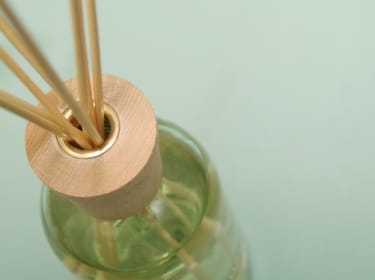Reed Diffusers: Household Risk

The Bottom Line
Reed diffusers are liquid air fresheners in a narrow-necked bottle with long "sticks" inserted in to the liquid. Ingredients vary, but two common ingredients can be dangerous to a child who swallows them.

The Full Story
Reed diffusers are liquid air fresheners in a narrow-necked bottle with long "sticks" inserted in to the liquid. These sticks, or reeds, absorb scented liquid from the container and release fragrance into the surrounding air. Many scents are available. Manufacturers range from widely-known consumer brands to small boutique producers. There are also recipes on the web for making your own air fresheners for use in reed diffusers.
The opening at the top is narrow, but not too narrow for a child to take a swig or spill the contents. Ingredients vary, but two common ingredients can be dangerous to a child who swallows them.
Some reed diffuser fragrances contain up to 70 percent isopropyl alcohol. This is the same thing as rubbing alcohol. Swallowing this can cause vomiting and make a child extremely drowsy.
Essential oils (e.g. lavender oil, eucalyptus oil) are also common ingredients. Swallowing these can cause drowsiness, tremors or seizures, stomach upset, and mouth irritation. Home recipes for diffuser fragrances may call for the same ingredients.
Isopropyl alcohol and essential oils can also cause skin and eye irritation. Of course, there is a danger that the long slender sticks could cause injury, too.
If you use air fresheners, they must be in some sort of sealed container so that children can't eat or drink them. If someone swallows air freshener, immediately use the webPOISONCONTROL® online tool or call Poison Control at 1-800-222-1222. If air fresheners spill on the skin, rinse with running water right away. If they splash in the eyes, rinse with running water for at least fifteen minutes. Then, use the webPOISONCONTROL online tool for guidance or call Poison Control at 1-800-222-1222. Both options will tell you exactly what to do.
Rose Ann Gould Soloway, RN, BSN, MSEd, DABAT emerita
Clinical Toxicologist
Poisoned?
Call 1-800-222-1222 or
Prevention Tips
If you use air fresheners, they must be in some sort of sealed container so that children can't eat or drink them.
This Really Happened
Case 1: Two brothers, both toddlers, got into the reed diffuser oil and were gagging. Their grandmother called Poison Control. Poison Control referred the boys into the nearest emergency room due to the risk of aspiration (inhaling a foreign substance into the respiratory tract) and breathing problems. Poison Control was in contact with the pediatric emergency physician to discuss these toxicity concerns and advised 6 hours of observation followed by a chest x-ray prior to discharge. Both boys had possible pneumonitis (inflammation of the lungs) on their chest x-rays and were admitted to the hospital. After 24-hours in the hospital they were stable and were sent home to follow up with their pediatrician. Two days later they still had what appeared to be pneumonitis on their x-rays but were doing well. Four days later one of the boys spiked a fever and had a slight cough. Both boys were evaluated by the pediatrician that day. A few days later their mother reported to Poison Control that the fever had resolved and both looked fine at the doctor's office that day.
Case 2: A 14-month-old girl spilled reed diffuser oil all over herself in the bathroom and was constantly coughing. Her parents called Poison Control. Poison Control referred the child in to the nearest emergency room due to the risk of aspiration (inhaling a foreign substance into the respiratory tract) and breathing problems. The pediatric emergency physician called Poison Control and was advised to observe the child for respiratory difficulty for 6 hours and to get a chest x-ray prior to discharging her home. Three hours later the child still had a cough in the emergency room, but it was less frequent. She had also developed a rash where the oil had gotten on her skin. The emergency physician reported that there were some changes on her initial chest x-ray but that she had had an upper respiratory infection prior to the exposure. However, a second x-ray 6-hours after the child got into the reed diffuser oil showed new changes, and the child was breathing fast and had a high fever. She was placed on antibiotics and admitted to the hospital. Twenty-four hours later the child was doing much better. She was in no respiratory distress and her fever had resolved. She was discharged to home, to follow-up with her pediatrician.
For More Information
Isopropyl alcohol (The Poison Post®)References
Crandon KC, Davies JTD, Thompson JP. Reed diffuser toxicity [Abstract]. Clinical Toxicology. 2010; 48(3): 285.Poisoned?
Call 1-800-222-1222 or
Prevention Tips
If you use air fresheners, they must be in some sort of sealed container so that children can't eat or drink them.
This Really Happened
Case 1: Two brothers, both toddlers, got into the reed diffuser oil and were gagging. Their grandmother called Poison Control. Poison Control referred the boys into the nearest emergency room due to the risk of aspiration (inhaling a foreign substance into the respiratory tract) and breathing problems. Poison Control was in contact with the pediatric emergency physician to discuss these toxicity concerns and advised 6 hours of observation followed by a chest x-ray prior to discharge. Both boys had possible pneumonitis (inflammation of the lungs) on their chest x-rays and were admitted to the hospital. After 24-hours in the hospital they were stable and were sent home to follow up with their pediatrician. Two days later they still had what appeared to be pneumonitis on their x-rays but were doing well. Four days later one of the boys spiked a fever and had a slight cough. Both boys were evaluated by the pediatrician that day. A few days later their mother reported to Poison Control that the fever had resolved and both looked fine at the doctor's office that day.
Case 2: A 14-month-old girl spilled reed diffuser oil all over herself in the bathroom and was constantly coughing. Her parents called Poison Control. Poison Control referred the child in to the nearest emergency room due to the risk of aspiration (inhaling a foreign substance into the respiratory tract) and breathing problems. The pediatric emergency physician called Poison Control and was advised to observe the child for respiratory difficulty for 6 hours and to get a chest x-ray prior to discharging her home. Three hours later the child still had a cough in the emergency room, but it was less frequent. She had also developed a rash where the oil had gotten on her skin. The emergency physician reported that there were some changes on her initial chest x-ray but that she had had an upper respiratory infection prior to the exposure. However, a second x-ray 6-hours after the child got into the reed diffuser oil showed new changes, and the child was breathing fast and had a high fever. She was placed on antibiotics and admitted to the hospital. Twenty-four hours later the child was doing much better. She was in no respiratory distress and her fever had resolved. She was discharged to home, to follow-up with her pediatrician.
